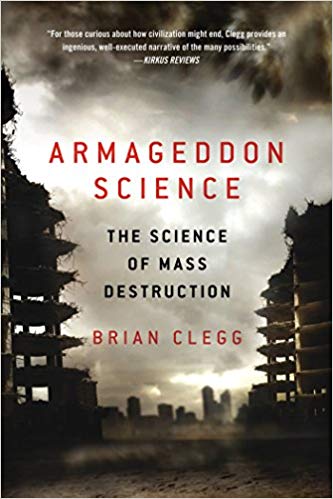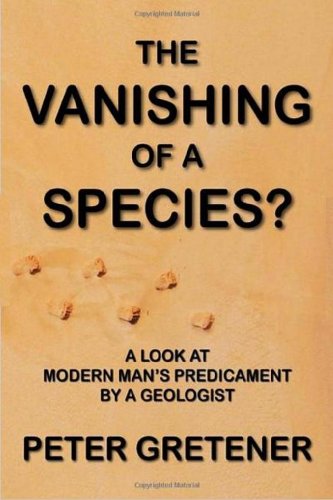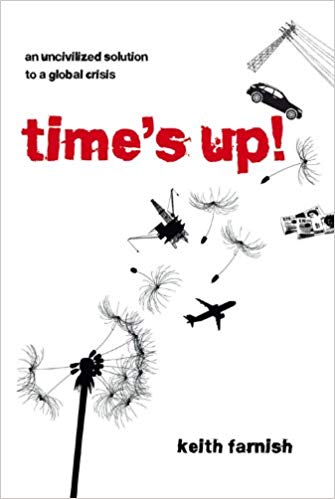The Omega Men
Armageddon Science: The Science of Mass Destruction
Brian Clegg. 2010. St. Martin’s Press, New York. 304 pages.
The Vanishing of a Species? A Look at Modern Man’s Predicament by a Geologist
Peter Gretener. 2010. Qualitas Publishing, Calgary, Alberta. 280 pages.
Time’s Up: An Uncivilized Solution to a Global Crisis
Keith Farnish. 2009. Green Books, Totnes, Devon. 256 pages.
Oscar-winning actor Charlton Heston earned acclaim in the 1950s and ’60s for his portrayals of Moses, Ben Hur and Michelangelo. But it was some of his later movies that attained cult status. Through the unintended apocalyptic trilogy—Planet of the Apes, The Omega Man and Soylent Green—Heston played out some of the most horrific futures Hollywood could dream up.
These movies seem almost childish, however, in comparison with the potential disasters outlined by the authors of several recent books. Some omit the idea of potential altogether; according to them we have already gone over the edge. Here we review the latest offerings of three of these omega men, each of whom lays out end-time possibilities that are just as disquieting as Heston’s films—maybe more so. Forty years on we have done little to step back from terrors that were once only imagined.
Pandora’s Lunch Box
“There is no free lunch” was one of Barry Commoner’s basic ecological concepts: for every benefit there is a cost. The cost of technology is its likelihood, either by accident or through misguided purpose, to reel out of control. And that is what people are interested in, after all—not how asteroids might wheel by again to end our world as they did the dinotopia 65 million years ago, but how we might destroy ourselves.
Science writer Brian Clegg cuts right to the point: “Mass destruction—killing on a vast scale—is a uniquely human concern.” Armageddon Science is a primer on just that—how we could kill ourselves: “As the continued popularity of disaster movies at the box office demonstrates, we are all too aware of how, as a race, we might be wiped out.”
We are surrounded with the comforts afforded us by the age of technology, of science applied to a bettering of the human condition. We enjoy the benefits, but as the book of Genesis notes, we do so under the shadow of the knowledge of both good and evil. “Our innate desire to know more, to investigate and to learn, rewards us with pain. And there is no going back.” We cannot “unbite the apple,” Clegg remarks.
In noting that technology always has unintended pushbacks, ecologist Paul Ehrlich has poignantly said, “We can’t have faith in technology pulling a rabbit out of a hat each time, because the rabbits always turn out to have dirty droppings.”
Technology is a two-edged sword able to cut out a clear path forward or to cut short the path entirely. Thus, as the human project (for lack of a better term) has advanced, there has always been the specter, the hovering sense of possible doom at our own hands. “In the last hundred years we have seen our ability to reap mass destruction from our science and technology blossom like a horrible flower,” Clegg says, and he does a reasonable job of laying out the garden of horrors. From the dense physics of the Large Hadron Collider creating a planet-swallowing black hole, to a self-reproducing nanobot infection creating worldwide electronic and biologic meltdown, the doomsayer updates our visions of cataclysm. No more planet of apes—just goo.
“Unlike human beings, even the most intelligent animals don’t worry about the possibility of being wiped out in a terrible catastrophe.”
Clegg’s ideas tend to get lost, however, in his telling of the minutiae. The reader is left with no idea of what to do now. Can the information be used in a helpful way? Apparently not, because “the genie is already out of the bottle.” In terms of nanotechnology, “just as it was impossible to forget the possibility of atomic weapons once the concept had been devised, we can’t go back to a time when the idea of nanobots hadn’t occurred to anyone. We are already at the stage of ‘the good guys had better build them, or it will only be the bad guys doing it.’”
Still, Clegg is trying to be optimistic, suggesting that with “caution and the right protection” we can move forward safely. His final chapter runs amok, however, suggesting that scientists are men with high-functioning autism, and repudiating politicians as know-nothings. This does little to build the optimism he intends. By way of summarizing his thesis, he concludes, “To say that Pandora’s box should remain shut is not the answer. . . . Take care. But do open the box.”
“It is only thanks to the human ability to contemplate the future that fears of mass destruction have arisen.”
Cultural Connections
Reflecting on the need for public input in decision-making, Britain’s Astronomer Royal, Sir Martin Rees, noted in a 2010 lecture: “Science isn’t just for scientists. All should have a voice in ensuring that it’s applied optimally, and to the benefit of both the developing and developed world.”
Earth scientist Peter Gretener, deriving his inspiration from a 1959 essay by novelist C.P. Snow, provides an outline for connecting the cultures of science and public understanding that Rees suggested.
Snow’s “The Two Cultures” is often seen as a benchmark document. In it he discussed the need for a meeting of the minds between scientist and nonscientist, a meeting that might reduce what he called the “subterranean back-chat” that plays one against the other. This is necessary, as Snow wrote and Gretener agrees, because while scientists invent, it is others who choose the applications. “If the scientists have the future in their bones, then the traditional culture responds by wishing the future did not exist,” Snow grumbled. His reference was to George Orwell’s 1984—the feared dystopia of a technology co-opted by politics. It is this kind of intellectualized hopelessness that Snow sought to overcome. He concluded, “It is the traditional culture, to an extent remarkably little diminished by the emergence of the scientific one, which manages the western world.”
Snow was really commenting on whether tradition can be enlightened by science. The partitioning of people skills (the humanities) from material skills and knowledge (the sciences) creates a problem, because the two cultures seem to see human nature differently. Is man inherently evil or good, precautionary or bold, individualist or collectivist?
Gretener’s concerns are similar. “These are questions that are not presently resolved,” he writes. “Unfortunately, these topics cannot be approached with the same detachment as rocks or the law of physics. Where man himself is involved, and we look essentially at ourselves, we are apt to become emotional and our unbiased scientific minds tend to be shrouded in the smoke that rises from our burnt egos.”
Certainly Gretener leans toward the empiricism of science; but a belief in the ostensibly unbiased nature of data may itself be more questionable than traditionally assumed. And the problem of right use rather than abuse still brings the debate to a standstill. Must every “could” be examined from every angle of “should”? Consensus would still likely fail, because, as the proverb states, our own way seems right in our own eyes, from our own perspective (Proverbs 14:12; 16:25). But the overall message in support of collaboration is worthy: “The task of this human revolution is a challenge that can only be met through a combined effort on the part of both the humanists and the scientists.”
Gretener suggests that because the separation persists, “our best brains are only responsible for a tiny fraction of human know-how.” Indeed, the specialization of the sciences and all areas of study have made people even more isolated, narrow and prone to inbred thinking. “The present haphazard approach results only in much talk and total inaction, a luxury which we can hardly afford.”
Posthumously edited and published by the author’s son, The Vanishing of a Species? is divided into 48 chapters, each more an essay or a thought than a complete analysis of an issue. The book’s promoters note that much of the writing was done in the 1970s, so the text is more a statement of philosophy than an examination of specific cases; this is a refreshing difference, contrasting with but complementing Clegg’s presentation.
The Radical Approach
The way to a brighter personal future is to begin making changes now, before life is severely disrupted by the imposition of ever more-negative changes or by the breakdown of the system itself. In Time’s Up, writer-activist Keith Farnish warns that we cannot do this fast enough. In fact (and this is most disquieting), he encourages the physical undermining of the status quo. His activist cause is to cut the pilings that support what he calls “Industrial Civilization.” It’s time for eco-jihad.
This is a most obvious omega move. Clegg and Gretener ignore the idea of ecoterrorism, but Farnish appears to be committed to it. Indeed, with his background in information technology, he can exert huge leverage on the system, or so he hopes. An IT security expert by training, he has devoted himself for several years to blogging and encouraging the subversion of civilization. “It will collapse on its own,” he remarks, “but not in time to save humanity.” In a disturbing sense, we have come full circle back to the doom scenarios of the movies: the confused, messianic, sabotage-minded individual. Farnish wants to be the savior who pushes the button, sending civilization-as-we-know-it over the edge; he comes across as a James Bond-esque villain, hyped up on dreams of Eden and of protecting the planet from man—and man from himself, of course.
In all this we are seeing played out another of Rees’s observations: a danger of the Internet is that “it promotes isolation and allows us (if we choose) more easily to evade the everyday contacts that would unavoidably bring us up against conflicting views.” The result can be that “those who interact only with the likeminded have their prejudices and obsessions reinforced, and shift towards more extreme positions” (Our Final Hour, 2003).
Farnish begins with reasoned discussion, but he then builds a path for the reader to “do something monumental.” The first chapters, under the heading “The Scale of the Problem,” lay out what we know about the interconnectedness of all life by traveling the continuum from the very small to the very large. Only toward the end does he begin to reveal his anger toward civilization and man’s power over nature. In a brief rant at NASA for colliding the Deep Impact probe with an asteroid, he questions, “What right do we have to affect a stellar object in this way? . . . ‘Civilized’ humans are now taking the devil-may-care attitude that has damaged so much, to the stars.”
In the second section, Farnish goes to great lengths to show that human beings are not special—no less or better than other organisms. He lauds a friend’s willingness to give his life to save a tree and puts it forward as evidence that some people do understand the value and rights of all life. But to the rest of us who would dodge the chain saw, he suggests that we need to be, shall we say, reprogrammed.
“For hundreds of millennia, humans connected tightly to the land and the life forms their survival depended upon, because that was how it had to be,” Farnish writes. But “this connection has ebbed away from the majority of humanity, in many cases to the extent that people feel nothing for anything humans have not created themselves. But we cannot eat concrete; we cannot breathe television; we cannot drink money.”
While it is true that these do not sustain us and can even distract us from the things that do, is the right response to preach that the world would be a better place if we all dug our own latrines, spun our own clothes and performed our own dental care, to name just a few of the duties that cooperative specialization allows us to share? And yet Farnish asks, “Hands up if you think Industrial Civilization should be stopped.”
Not many hands will go up, though, because Farnish fails to convince the reader to feel deceived about civilization. He wants us to dislike the city. This is his real target; it is the locus of unsustainability, the pinnacle of the unnatural. “This is what it means to be ‘civilized,’” he writes with exasperation. “The city dweller . . . is cut off from his life support system. The food, clothes, building materials, even the energy, may as well come from another world.” The fact that so many people now live in urban settings must therefore be undone.
Still, it is easy to agree with his argument that we are embedded in a civilization that has made all the wasteful, exploitative things easy, and the honest, equitable and kind things seem foolish or too difficult. Too many have accepted as essentially good those practices that disconnect, such as consumption for the sake of consumption and finding happiness in trivia (a high video game score, for example). Practices that have led to human and environmental abuse, disenfranchisement and economic enslavement have also made life in the metropolitan West easy and inexpensive, so most overlook them. Farnish is right in believing that these are all symptoms of a way of life that must eventually come to an end.
The Alpha and the Omega
Farnish’s recognition of the need for change notwithstanding, much of what he suggests in the final section of the book must be discounted; the kind of hands-on sabotage that he advocates is simply not justified. What he has termed the “Tools of Disconnection,” however, are worth every reader’s second look: lies, abuse, fear, false hope and exploitation of trust, among others. These are more than mere means to control people, to maintain the power of one group over another. Farnish believes they are the means through which we are deceived away from a more nature-centric life, but they are much more powerful than even that. They represent the ugly side of the human nature that is a part of each one of us. How civilization “works”—its standard operating procedure—must therefore be changed.
And so Farnish is both right and wrong when he writes, “Undermining [these disconnecting practices] helps create the conditions for change and allows that change to accelerate, rather than be dragged backwards by the influence of civilization.” In the hands of man, change will not ultimately be for the good. Human attempts at doing right, whether overt or covert, technological or psychological, have failed to bring peace and sustainability to the world we share. Until human nature changes, we can’t expect different results than we’ve had to this point. Instead, humanity’s best efforts would destroy humanity if allowed to run its natural trajectory.
Sir Martin Rees recognizes humanity’s precarious hold on the future. He told Vision, “I believe we have entered a century that is going to confront us with unprecedented ethical challenges, risks and opportunities. These are all things that a wide public has to be aware of. Although scientists may be responsible for these changes, it is not just scientists who will need to confront them and certainly not scientists who need to address the ethical issues.”
Indeed we are all traveling this path together. These writers see many of the obstacles ahead, but few are sure of where the path leads. Is preserving the species, or even the planet, the ultimate in human meaning? Recognizing that there is more to human existence than can be found in nature—even the most satisfyingly imagined reconnection with nature—is beyond our normal vision. That would take extraordinary insight—the kind that only someone with a higher perspective, a beginning-to-end view, can provide.



